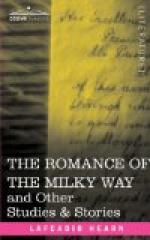But the most curious Izumo custom relating to the festival was the N[’e]mu-nagashi, or “Sleep-wash-away” ceremony. Before day-break the young folks used to go to some stream, carrying with them bunches composed of n[’e]muri-leaves and bean-leaves mixed together. On reaching the stream, they would fling their bunches of leaves into the current, and sing a little song:—
N[’e]mu wa, nagar[’e] yo!
Mam[’e] no ha wa, tomar[’e]!
These verses might be rendered in two ways; because the word n[’e]mu can be taken in the meaning either of n[’e]muri (sleep), or of nemuri-gi or n[’e]munoki, the “sleep-plant” (mimosa),—while the syllables mam[’e], as written in kana, can signify either “bean,” or “activity,” or “strength,” “vigor,” “health,” etc. But the ceremony was symbolical, and the intended meaning of the song was:—
Drowsiness, drift away!
Leaves of vigor, remain!
After this, all the young folk would jump into the water, to bathe or swim, in token of their resolve to shed all laziness for the coming year, and to maintain a vigorous spirit of endeavor.
* * * * *
Yet it was probably in Y[’e]do (now T[=o]ky[=o]) that the Tanabata festival assumed its most picturesque aspects. During the two days that the celebration lasted,—the sixth and seventh of the seventh month,—the city used to present the appearance of one vast bamboo grove; fresh bamboos, with poems attached to them, being erected upon the roofs of the houses. Peasants were in those days able to do a great business in bamboos, which were brought into town by hundreds of wagonloads for holiday use. Another feature of the Y[’e]do festival was the children’s procession, in which bamboos, with poems attached to them, were carried about the city. To each such bamboo there was also fastened a red plaque on which were painted, in Chinese characters, the names of the Tanabata stars.
But almost everywhere, under the Tokugawa r[’e]gime, the Tanabata festival used to be a merry holiday for the young people of all classes,—a holiday beginning with lantern displays before sunrise, and lasting well into the following night. Boys and girls on that day were dressed in their best, and paid visits of ceremony to friends and neighbors.
* * * * *
—The moon of the seventh month used to be called Tanabata-tsuki, or “The Moon of Tanabata.” And it was also called Fumi-tsuki, or “The Literary Moon,” because during the seventh month poems were everywhere composed in praise of the Celestial Lovers.
* * * * *




